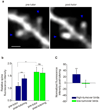Rapid spine stabilization and synaptic enhancement at the onset of behavioural learning
- PMID: 20164928
- PMCID: PMC2918377
- DOI: 10.1038/nature08759
Rapid spine stabilization and synaptic enhancement at the onset of behavioural learning
Abstract
Behavioural learning depends on the brain's capacity to respond to instructive experience and is often enhanced during a juvenile sensitive period. How instructive experience acts on the juvenile brain to trigger behavioural learning remains unknown. In vitro studies show that forms of synaptic strengthening thought to underlie learning are accompanied by an increase in the stability, number and size of dendritic spines, which are the major sites of excitatory synaptic transmission in the vertebrate brain. In vivo imaging studies in sensory cortical regions reveal that these structural features can be affected by disrupting sensory experience and that spine turnover increases during sensitive periods for sensory map formation. These observations support two hypotheses: first, the increased capacity for behavioural learning during a sensitive period is associated with enhanced spine dynamics on sensorimotor neurons important for the learned behaviour; second, instructive experience rapidly stabilizes and strengthens these dynamic spines. Here we report a test of these hypotheses using two-photon in vivo imaging to measure spine dynamics in zebra finches, which learn to sing by imitating a tutor song during a juvenile sensitive period. Spine dynamics were measured in the forebrain nucleus HVC, the proximal site where auditory information merges with an explicit song motor representation, immediately before and after juvenile finches first experienced tutor song. Higher levels of spine turnover before tutoring correlated with a greater capacity for subsequent song imitation. In juveniles with high levels of spine turnover, hearing a tutor song led to the rapid ( approximately 24-h) stabilization, accumulation and enlargement of dendritic spines in HVC. Moreover, in vivo intracellular recordings made immediately before and after the first day of tutoring revealed robust enhancement of synaptic activity in HVC. These findings suggest that behavioural learning results when instructive experience is able to rapidly stabilize and strengthen synapses on sensorimotor neurons important for the control of the learned behaviour.
Figures





Similar articles
-
Dissociation between extension of the sensitive period for avian vocal learning and dendritic spine loss in the song nucleus lMAN.Neurobiol Learn Mem. 2005 Mar;83(2):143-50. doi: 10.1016/j.nlm.2004.11.002. Neurobiol Learn Mem. 2005. PMID: 15721798
-
Experience-Dependent Intrinsic Plasticity During Auditory Learning.J Neurosci. 2019 Feb 13;39(7):1206-1221. doi: 10.1523/JNEUROSCI.1036-18.2018. Epub 2018 Dec 12. J Neurosci. 2019. PMID: 30541908 Free PMC article.
-
Hemispheric dominance in HVC is experience-dependent in juvenile male zebra finches.Sci Rep. 2024 Mar 9;14(1):5781. doi: 10.1038/s41598-024-55987-6. Sci Rep. 2024. PMID: 38461197 Free PMC article.
-
The sensitive period for auditory-vocal learning in the zebra finch: Consequences of limited-model availability and multiple-tutor paradigms on song imitation.Behav Processes. 2019 Jun;163:5-12. doi: 10.1016/j.beproc.2017.07.007. Epub 2017 Jul 23. Behav Processes. 2019. PMID: 28743517 Free PMC article. Review.
-
Cellular, circuit, and synaptic mechanisms in song learning.Ann N Y Acad Sci. 2004 Jun;1016:495-523. doi: 10.1196/annals.1298.035. Ann N Y Acad Sci. 2004. PMID: 15313792 Review.
Cited by
-
Analysis of excitatory synapses in the guinea pig inferior colliculus: a study using electron microscopy and GABA immunocytochemistry.Neuroscience. 2013 May 1;237:170-83. doi: 10.1016/j.neuroscience.2013.01.061. Epub 2013 Feb 6. Neuroscience. 2013. PMID: 23395860 Free PMC article.
-
Auditory signal processing in communication: perception and performance of vocal sounds.Hear Res. 2013 Nov;305:144-55. doi: 10.1016/j.heares.2013.06.007. Epub 2013 Jul 1. Hear Res. 2013. PMID: 23827717 Free PMC article. Review.
-
Alteration of synaptic network dynamics by the intellectual disability protein PAK3.J Neurosci. 2012 Jan 11;32(2):519-27. doi: 10.1523/JNEUROSCI.3252-11.2012. J Neurosci. 2012. PMID: 22238087 Free PMC article.
-
Astrocytes Control Synapse Formation, Function, and Elimination.Cold Spring Harb Perspect Biol. 2015 Feb 6;7(9):a020370. doi: 10.1101/cshperspect.a020370. Cold Spring Harb Perspect Biol. 2015. PMID: 25663667 Free PMC article. Review.
-
Silencing PP2A inhibitor by lenti-shRNA interference ameliorates neuropathologies and memory deficits in tg2576 mice.Mol Ther. 2013 Dec;21(12):2247-57. doi: 10.1038/mt.2013.189. Epub 2013 Aug 7. Mol Ther. 2013. PMID: 23922015 Free PMC article.
References
-
- Chklovskii DB, Mel BW, Svoboda K. Cortical rewiring and information storage. Nature. 2004;431(7010):782–788. - PubMed
-
- Engert F, Bonhoeffer T. Dendritic spine changes associated with hippocampal long-term synaptic plasticity. Nature. 1999;399(6731):66–70. - PubMed
-
- Alvarez VA, Sabatini BL. Anatomical and physiological plasticity of dendritic spines. Annu Rev Neurosci. 2007;30:79–97. - PubMed
Publication types
MeSH terms
Grants and funding
LinkOut - more resources
Full Text Sources

